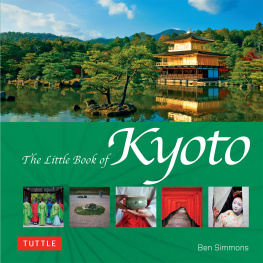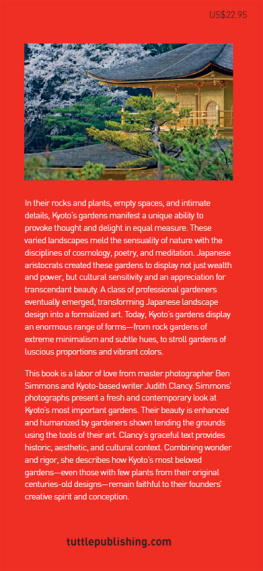About Tuttle Books to Span the East and West
Our core mission at Tuttle Publishing is to create books which bring people together one page at a time. Tuttle was founded in 1832 in the small New England town of Rutland, Vermont (USA). Our fundamental values remain as strong today as they were thento publish best-in-class books informing the English-speaking world about the countries and peoples of Asia. The world has become a smaller place today and Asias economic, cultural and political influence has expanded, yet the need for meaningful dialogue and information about this diverse region has never been greater. Since 1948, Tuttle has been a leader in publishing books on the cultures, arts, cuisines, languages and literatures of Asia. Our authors and photographers have won numerous awards and Tuttle has published thousands of books on subjects ranging from martial arts to paper crafts. We welcome you to explore the wealth of information available on Asia at www.tuttlepublishing.com.
Acknowledgments and Credits
John Dougill would like to acknowledge the invaluable assistance of Yuriko Suzuki, who facilitated much of the research, and also the expertise of Thomas Kirchner, who kindly showed me around Rinsen-ji, part of the great monastical complex of Tenryu-ji. I am also very grateful to Rev. Takafumi Kawakami for making time in his busy schedule, and to novelist Julie Highmore for reading over the text. I am indebted, too, to several experts in the field. These include prominent academics such as John Nelson, George Keyworth, Robert Borgen, Hoyu Ishida and Eisho Nasu. I was also fortunate to have the support of Zen priest Tom Wright, landscape designer Tomoki Kato, Japan journalist Eric Johnston, shakuhachi maestro Preston Houser, Kyoto Journal editor Ken Rodgers, former Kyoto city official Shigenori Shibata, Kyoto author Judith Clancy, garden expert Mark Hovane, and two International Goodwill Ambassadors for the City of Kyoto, Jeff Bergland and tea master Randy Channell. Thanks also to photographer Damien Douxchamps. Finally, I would like to restate my gratitude to scholar Michel Mohr for the invaluable input he provided on a previous occasion when I wrote about Zen in Kyoto, and also for the encouragement of author Norman Waddell. My sincere thanks to one and all.
The quotation from Ruth Fuller Sasaki in the Introduction is an abridged version of an article included in Zen Pioneer: The Life and Works of Ruth Fuller Sasaki by Isabel Stirling, published by Shoemaker and Hoard in the US, 2006, pages 198203. The original piece was by Ruth Fuller Sasaki for a 1960 pamphlet titled Rinzai Zen Study for Foreigners in Japan, published privately in Kyoto by the First Zen Institute of America in Japan.
John Einarsen is extremely grateful for the help he received in taking photographs for this book. First and foremost are two Zen priests who are playing a crucial role in introducing Zen to overseas visitors: Rev. Takafumi Kawakami of Shunko-in and Rev. Daiko Matsuyama of Taizo-in. They graciously allowed me to photograph at their temples on several occasions. I especially wish to express my deep gratitude to the deputy priest of Ikkyu-ji, Soko Tanabe, who posed for some of the photographs, and to his wife who prepared tea and sweets. This encounter never would have materialized if it were not for the kind help of Kyoto photographers Hideyuki and Kayu Mizuno. I would like to thank Gensho Hozumi of Toko-ji and the International Zen Center for hosting me on several occasions, and Sage Morita Einarsen for his amazing temple compound illustration on pages . Others who helped include the many monks at the temples who answered my simple questions, Thomas Kirchner, garden designer Marc P. Keane, Kyoto Journal s Ken Rodgers and Toshihiro Hagimori, who first encouraged me to do a book like this many years ago. Finally, I would like to express my appreciation to Midori Morita who accompanied me to many of the temples. She was a fun, patient and helpful companion on these trips.
contents
Authors Note
Names are written in Japanese fashion (family name before given name), except for contemporary and modern figures who are referred to in the Western style.

Baisao, the legendary Edo-era tea seller, was a poet and Obaku monk who is enshrined at Manpuku-ji. Painting by Ito Jakuchu.
Published by Tuttle Publishing, an imprint of Periplus Editions (HK) Ltd
www.tuttlepublishing.com
Copyright 2017 Periplus Editions (HK) Ltd Page 86Source: Wikimedia Commons
All rights reserved. No part of this publication may be reproduced or utilized in any form or by any means, electronic or mechanical, including photocopying, recording, or by any information storage and retrieval system, without prior written permission from the publisher.
ISBN 978-4-8053-1401-2; ISBN 978-1-4629-1958-1 (ebook)
Distributed by
North America, Latin America & Europe
Tuttle Publishing
364 Innovation Drive
North Clarendon, VT 05759-9436 U.S.A.
Tel: 1 (802) 773-8930; Fax: 1 (802) 773-6993
Japan
Tuttle Publishing
Yaekari Building 3rd Floor
5-4-12 Osaki Shinagawa-ku, Tokyo 141-0032
Tel: (81) 3 5437-0171; Fax: (81) 3 5437-0755
Asia Pacific
Berkeley Books Pte. Ltd.
61 Tai Seng Avenue, #02-12, Singapore 534167
Tel: (65) 6280-1330; Fax: (65) 6280-6290
20 19 18 17 10 9 8 7 6 5 4 3 2 1
Printed in China 1708CM
TUTTLE PUBLISHING is a registered trademark of Tuttle Publishing, a division of Periplus Editions (HK) Ltd.


The Daruma of Toji-in.

A contemporary shakuhachi flute player.

View of the garden at Shisendo.

Early spring in Nanzen-ji.

 Zen in Kyoto
Zen in Kyoto
Each year I receive around 5,000 visitors to my temple who want to learn about Zen. They come from many different nationalities and backgrounds, ranging from businessmen to travelers and university students. Many have misconceptions about Zen, but nearly all are interested in developing and practicing mindfulness in their lives.
Over the centuries, the Zen world in Kyoto has developed a unique culture in terms of focussing attention. It is evident in such Zen arts as the tea ceremony and Chinese ink work. Its influence can be seen also in architecture, garden design, Japanese archery and martial arts. We can, in fact, find this clear, concentrated attention reflected in all aspects of Zen culture.
Next page






















 Zen in Kyoto
Zen in Kyoto